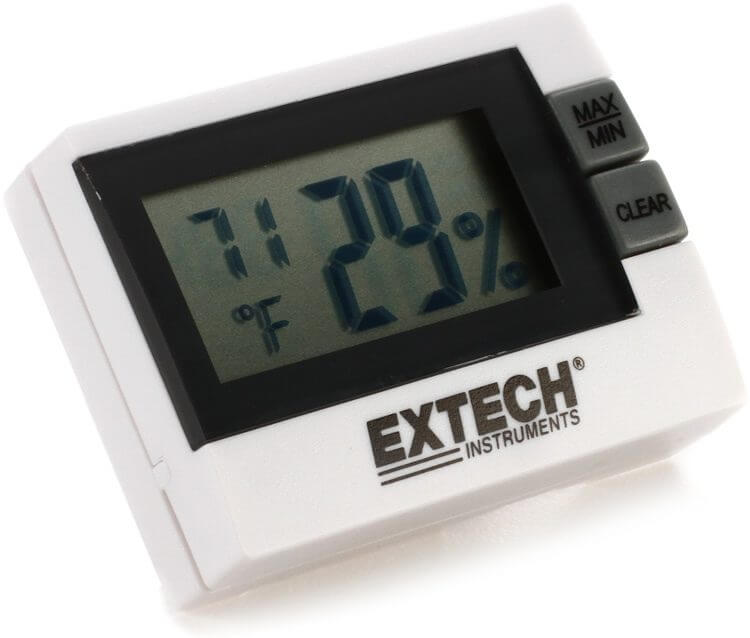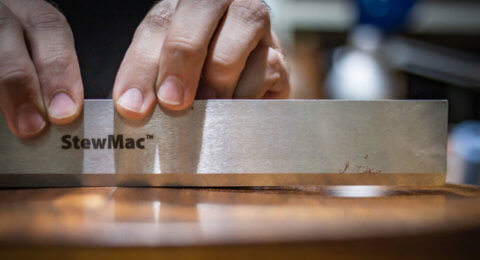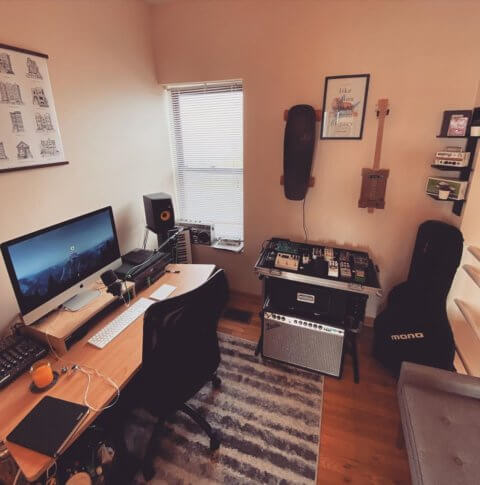Now that you’re familiar with some of the signs of humidity damage, here are some useful tips to help you best take care of your guitars. Haven’t read Part 1? Click here.
Take the necessary measures based on the environment you’re in to help you monitor, and ultimately prevent, humidity-related damage. These tips can also help speed up the restoration process of a guitar that already shows signs of water damage.
Monitoring humidity
You’re in the middle of winter, but your radiator is on. How’s your guitar doing?
Skip the guesswork with a hygrometer. These sensors monitor humidity and temperature changes throughout the day and providing you with accurate readings. This reduces the chances of you over-humidifying or drying out your guitars.

Take note that humidity levels may not be consistent within the same room. Keep the hygrometer in the vicinity of your guitars for the most accurate reading.
You can also use your hygrometer to find the most ideal spot in your room for your guitars.
Keep your guitars in their cases
Here’s a great rule-of-thumb to live by: the smaller the space, the easier it is to manage humidity levels for your guitar.
Any type of guitar case or bag can help you simulate a compact environment for your guitar, but case quality still matters.
A cheap hard case may not provide a better moisture seal than a modern gig bag. Similarly, a flimsy canvas bag will allow moisture to pass through the fabric easily.
If you already own a MONO case, consider storing your guitars away when you’re not using them. Our weather resistant Sharkskin case fabric (not actual shark skin) and thick padding act as a moisture barrier. This helps keep excess moisture out during wet, summer months, and moisture in during dry, winter months.
Invest in a humidifier and/or dehumidifier
Now that you’ve got your hygrometer and your case of choice, what’s next?
Pair your case with a dehumidifier/ humidifier, and you can create a mini-humidor for your guitar to thrive in.

If you’re caring for an acoustic guitar, many humidifier packs are designed to go inside an acoustic guitar’s sound hole. However, it still helps to have secondary humidifying packs around the guitar body if you live in a particularly humid environment.
Have a MONO case? There’s also enough room around our Headlock neck braces to fit portable dehumidifying or humidifying systems.
If you prefer to keep your guitars out on a wall, or on a stand, you will need a room humidifier/ dehumidifier. These units are typically costly and require daily maintenance. Make sure to keep your room humidifier/ dehumidifier close to your instruments, and regularly empty or fill the water reservoir to keep it functioning.
Book a seasonal setup
Seasonal changes typically cause your guitar’s neck to move and guitar body tops to fluctuate. Naturally, this means that guitars in more temperate environments will need adjustments more regularly.

Electric guitars are not immune to seasonal adjustments either — any wooden instrument will need maintenance during a seasonal shift in temperature and humidity.
What should I NOT be doing?
Doing nothing! Here are some additional tips to keep your guitars safe from drastic humidity changes:
- Keep your instrument away from windows — they are not well insulated against daily temperature and humidity changes. The view may be inspiring, but window spots are not reliable guitar storage spaces.
- When traveling, never leave your guitar in your car boot for extended periods. You run the risk of overheating or freezing your guitar.
Some people think it is enough for the guitars to be stored in an air-conditioned room during hot seasons. Unfortunately, air-conditioning does not truly hold humidity at a constant level, and very few of us leave the air-conditioning on all the time.
As we mentioned in Part 1, acoustic guitars bear the brunt of humidity damage, but that doesn’t mean that solid body electric instruments are spared. Storing your guitars away in a well-sealed case will help extend the life of your fretboard and all metal parts on your beloved guitar
In conclusion
Whether you’re trying to introduce moisture content or remove it from your guitar, the end goal is the same. Guitars should be kept as close to 40-50% humidity as possible for optimum playability throughout the year.
The best thing you can do for yourself is to never be complacent about humidity. Be prepared to monitor it all year round to extend the life and playability of your guitars.
Some guitar owners are fortunate to live in areas with ideal humidity levels that allow for low guitar maintenance. However, for the majority of us, humidity control is a very regular part of guitar ownership.
As with most things in life, prevention is always better than cure (or repairs in this case).
–
Looking for a reliable guitar case? Head to our store to check out our full range of MONO cases.
Special thanks to luthier James Gay of Well Played Gear for sharing his invaluable insight with us as we put this piece together


